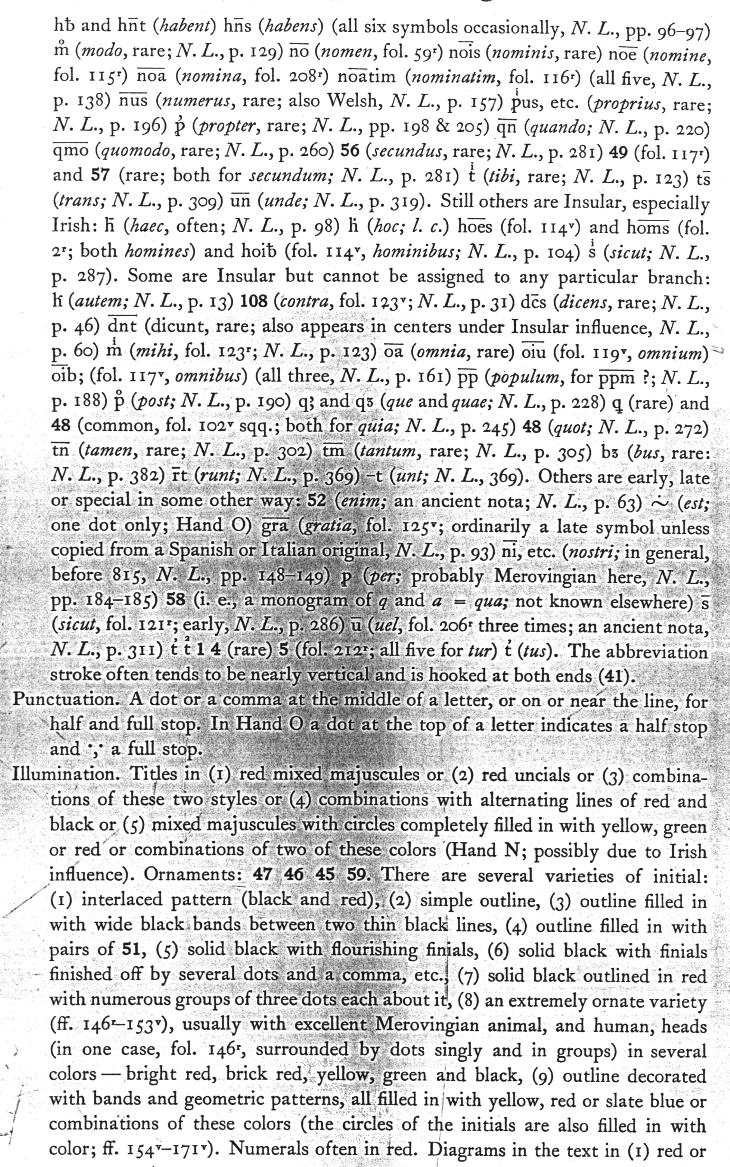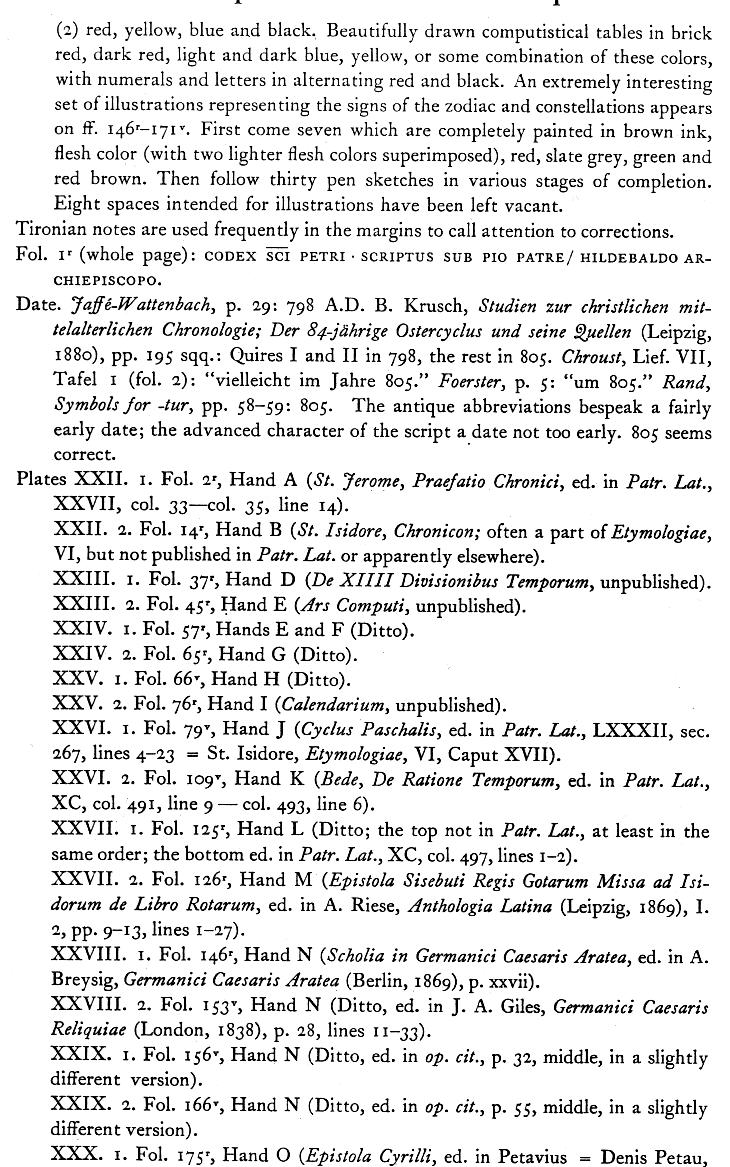Leslie Webber Jones: The Script of Cologne from Hildebald
to Hermann. Cambridge, Mass., 1932. S. 18-21, 37-40.
Der Text enthält eine Fülle von Sonderzeichen, so daß er nicht vollständig in ein HTML-Format überführt werden
kann, sondern teilweise als Abbildung der Textseiten angeboten wird.
Chapter Four: A Brief Account of the Development of
the Script of Cologne.
Period II. The Middle Hildebaldian Period.
Seite 18, 19, 20,
21.
Description of the Manuscripts
Period II. The Middle Hildebaldian Period.
Seite 37, 38, 39,
40.
Seite 18:
Period II. The Middle Hildebaldian Period3
There is further progress in the simplification
of the merovngian hand. While a few scribes4
are as any of the preceding period in their retention of wildly cursive
peculiarities, the majority carry on the process of elimination until they
3. Roughly 801-810.
4. See Plates LII. 2 (No. 10); LIII-LVIII.
2 (No. 11); LX (No. 12).
Seite 19:
succeed in producing a fairly clear script. The battle has been won. The
Caroline minuscule, the goal of earlier Hildebaldian times, has been definitely
attained. It is here to stay, despite its crudeness, its irregularity,
its failure to observe one norm and one only.
In this, as doubtless in the first, period the development at Cologne has
obviously been accelerated by influence from other centers of writing.
For the first time we can say certainly that the stateliness and elegance
of the style of Tours are being imitated.1
That this should be the case is perfectly natural. We know, for example,
that there was intellectual intercourse between Tours and Cologne at this
time, for Alcuin sent at least one manuscript which was received and probably
copied at Cologne.2 This manuscript (and no doubt others) must
have been responsible for the influence which became increasingly importan
t in subsequent periods. The Tours minuscule with its clear, round, letters
and its virtual elimination of cursive traits3 must have appealed
strongly to the scribes of Cologne. Of course we are not to think for a
moment that Tours was the only center with which Cologne was in contact,
but the excellence of the script of Tours at this time and later made it
a particularly worthy model.
The Insular, and particularly the Irish, influence continues in the minuscule,
in the abbreviations, and in the illumination. One hand is obviously written,
in pointed style, by an Irish scribe trained in an English scriptorium.4
A second is Anglo-Saxon.5 A third shows the effect either of
an Irish rounded model or of Irish mannerisms forced into Continental traces.6
Again, the genres of script are not well distinguished, though in
some instances, there is an advance. The uncials are occasionally well
formed,7 but they are usually imperfect or mixed with minuscules
or square or rustic capitals. Square capitals of a pure variety are extremely
rare.8 As in Period 1, the characteristic letters for important
titles are mixed majuscules, that is, square capitals, uncials and a few
minuscules combined into a single style. These mixed majuscules, crude
as they sometimes are, are not without a certain effectiveness. Rustic
capitals are neither common nor well made. There are sporadic attemp ts
to set up a simple hierarchy of scripts: square capitals, uncials, minuscules
and the like.9
The illumination is somewhat more elaborate than before. Colors are no
longer restricted to black ink and red, but yellow, green, purplish blue
and other shades appear in abundance. Letters are often filled in with
one or more of these colors and not infrequently a whole word or phrase
is overlaid by a horizontal line of paint. Red dots sometimes surround
a capital in the Irish manner, singly or in groups of three. Angular capitals
(C, G and a reversed-Z form of S10), dots and
commas within the circles of capitals, small capitals within, or superimposed
upon, larger ones are still in favor. Early B and R with
top loops separated from the bottom of the letters are also popular. Ornaments
are either the plain variety found in Period 1 or equally
1. See Plates XXII. I and 2 (No. 6); XXXVI, bottom and XXXVII, top (No.
7).
2. Speculum, IV, No. I, p. 61.
3. Rand, Tours, pp. 8-9.
4. Hand N of No. 7.
5. Hand Q of No. 7.
6. Hand J of No. 11.
7. Here. and there in Nos. 7 and 8.
8. Occasionally in Nos. 7 and 8.
9. In Nos. 6 and 7, e.g.
10. No. 10.
Seite 20:
simple arrangements of dots and commas. Initials are often mere outlines filled in
with lines of various kinds (some suggesting the fading-out of Merovingian animal
patterns) as in Period 1, but they are frequently colored. There are the usual conventionalized plaited patterns and others of a more natural type. There are solid black initials, sometimes outlined in red, sometimes with flourishing finials (occasionally forked or finials decorated at the ends with dots and a comma or leaves. Finally, there are Merovingian patterns, with heads of men as well as of animals, painted in red, yellow and slate blue. Small incidental initials (uncials usually, rarely Irish uncials) are occasionally conventionalized and given elaborate finials.1
The computistical treatises of No. 6 are considerably enlivened by a series of
illustrations representing the signs of the zodiac and the constellations. Seven of
these pictures are in color (brown ink, three shades of a flesh color, red, slate grey, green and red brown); thirty are pen sketches in various stages of completion; eight blank spaces have not been filled in at all. The illustrations are crude, but they are vigorous and effective.2 They are important to the historian of art as examples of the sort of work done at Cologne at this time.

If I am correct in my judgment, one and the same scribe appears in two different
manuscripts.7 With due allowance for this fact, no less than eighty-three to eighty-five scribes are working in this period (if, as before, contemporary minor relieving hands be counted). Since there are undoubtedly more manuscripts to be attributed to this time, this number represents only the minimum. Still, it is a much larger number than that of the preceding period.
There is an extension, but not a very wide one, in intellectual interests. Theological matters hold the front rank. Three manuscripts contain works by Fathers of the
1. No. 9, e.g.
2. See Plate IX. 1 and 2.
3. There are many in No. 6.
4. Nos. 6, 7, 13 (part).
5. Nos. 7 (part) , 9, 11, 12 (part), 13.
6. There are traces of the press-mark in erasure in No. 12.
7. AS Hand B of No. 9 and Hand C of No. 12.
Seite 21:
Church: No. 8, St. Jerome's Commentaries on Micah, Habakkuk and Zephania, No. 13, St. Jerome's Commentaries on amos (last part), Jonah, Zechariah and Malachia, and No. 12, St. Augustine, De Doctrina Christiana and Contra Manicheos. Two evidence a curiosity, and no doubt a pride, in distinguished Popes: No. 9, Selected Letters of Gregory the Great, and No. 11, Gesta Pontificum Romanorum. One (No. 7) contains various writings of Alcuin and of Bede. Two more are collections of canons, the first (No. 10) the so-called "Dionysio-Hadrianea", the second (No. 14) the "Dacheriana". The last (No. 6, Computistical treatises) indicates that the study of the calendar was still as lively as ever.
Seite 37:

Seite 38:

Seite 39:

Seite 40:





